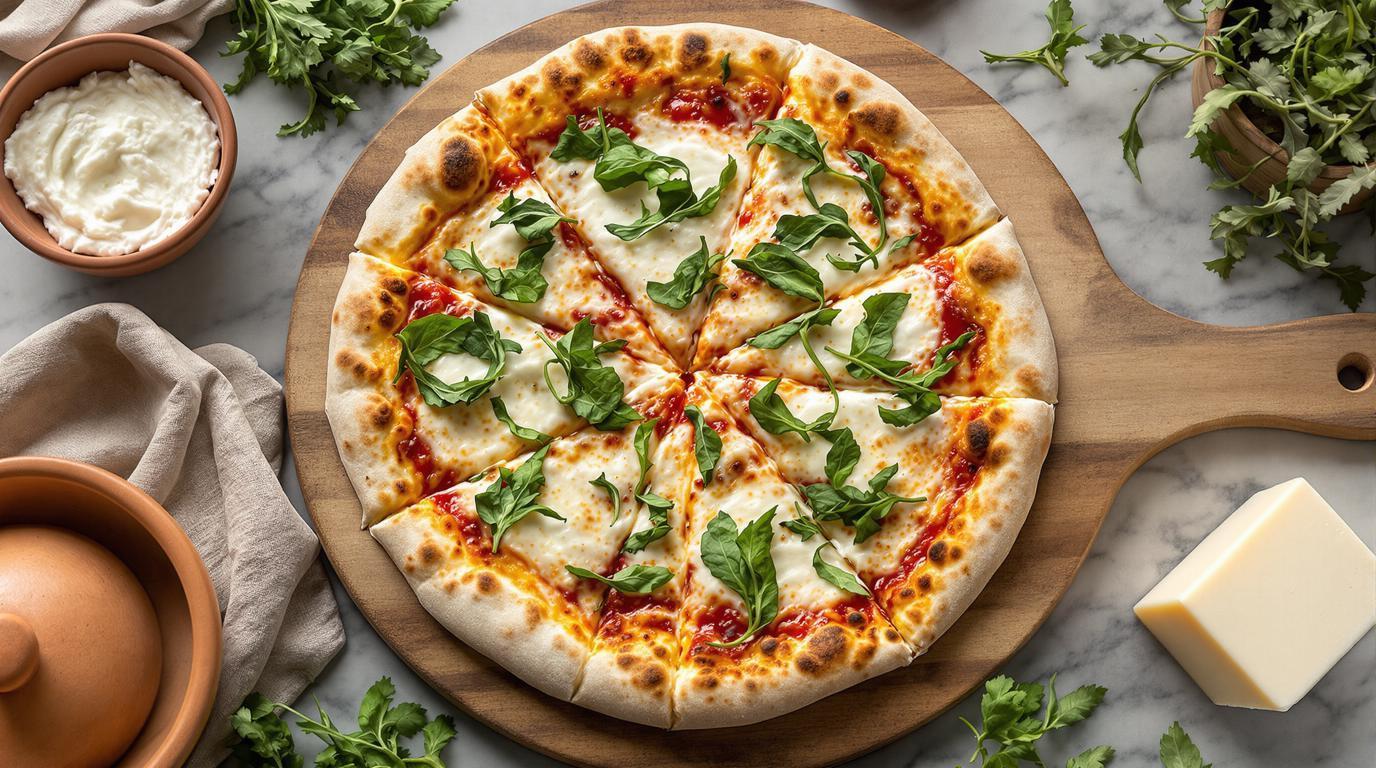The first time I encountered a truly exceptional pizza bianca was during a culinary workshop in Rome’s Trastevere district. While everyone else flocked to the tomato-based classics, I was drawn to this deceptively simple creation. What struck me wasn’t just its elegant appearance – that perfect contrast between the golden crust and vibrant green arugula – but how the minimal ingredient list created such profound flavor. This isn’t just white pizza; it’s proof that restraint often yields the most remarkable results when each element is treated with reverence.
The Story 📖
Pizza bianca (“white pizza”) originated in Rome as a humble flatbread, typically dressed with just olive oil and salt. What we’re creating today evolved from that tradition, highlighting the northern Italian preference for peppery arugula and aged Parmesan. Unlike its sauce-laden cousins, this version celebrates each ingredient’s pure essence – the creamy richness of ricotta, the nutty complexity of Parmesan, and the peppery brightness of fresh arugula. It’s the perfect canvas for Mediterranean flavors at their most refined.
Ingredients Spotlight 🧪
For the dough (makes 2 pizzas):
- 270g (2¼ cups) strong bread flour – the higher protein content creates that perfect chewy-crisp texture
- 7g (2¼ tsp) fast-action dried yeast
- ½ tsp sea salt – I prefer flaky sea salt for better distribution
- ½ tsp caster sugar
- 2 Tbsp extra virgin olive oil, plus extra for drizzling
- 160ml (⅔ cup) lukewarm water – around 105°F/40°C, not hotter
For the toppings:
- 150g (⅔ cup) fresh ricotta – room temperature spreads more easily
- 2 Tbsp freshly grated Parmesan, plus extra for finishing
- 1 tsp garlic powder or 2 cloves fresh garlic, finely minced
- 125g (1¼ cups) shredded low-moisture mozzarella
- 160g (5.5oz) pancetta, diced (optional but traditional)
- 2 handfuls fresh arugula (about 2 cups, loosely packed)
- Flaky sea salt and freshly cracked black pepper
- High-quality extra virgin olive oil for finishing
Step-by-Step Guide 📝
1. Prepare the dough: In a large bowl, combine flour, yeast, salt, and sugar. Make a well in the center and pour in olive oil and lukewarm water. Mix until incorporated, then turn onto a floured surface and knead for 8-10 minutes until smooth and elastic. The dough should pass the “windowpane test” – when stretched, it should become thin enough to see light through without tearing.
2. First rise: Place the dough in a lightly oiled bowl, cover with a damp cloth, and let rise in a warm spot for 60 minutes or until doubled in size.
3. Shape the base: Divide the dough into two equal portions. On a floured surface, gently stretch or roll each piece into a 12-inch (30cm) circle. Transfer to baking sheets lined with parchment paper and let rest for 5 minutes – this prevents the dough from shrinking back.
4. Prepare the base layer: Mix ricotta, Parmesan, and garlic in a small bowl. Spread this mixture evenly over each dough circle, leaving a ½-inch border for the crust. This creates a protective barrier that prevents the dough from becoming soggy.
5. Add toppings: Sprinkle mozzarella evenly over the ricotta layer. If using pancetta, distribute it across the surface.
6. Bake to perfection: Preheat your oven to its maximum temperature (ideally 475-500°F/240-260°C) with a pizza stone or inverted baking sheet inside. Slide the prepared pizza onto the hot surface and bake for 8-10 minutes until the crust is golden and the cheese is bubbling with light brown spots.
7. Finish with fresh elements: Immediately top the hot pizza with fresh arugula, extra Parmesan shavings, a drizzle of olive oil, and a light seasoning of flaky salt and freshly cracked pepper.
Expert Techniques 🛠️
The secret to exceptional pizza bianca lies in temperature control. Your oven should be scorching hot – professional pizza ovens reach 800°F/425°C, so we need to compensate by preheating thoroughly. Place your pizza stone or baking sheet in the oven for at least 45 minutes before baking.
Chef’s Note: For an elevated version, infuse your olive oil with garlic and herbs the day before. Simply warm 1 cup of olive oil with 6 crushed garlic cloves and a sprig of rosemary over low heat for 20 minutes, then strain and cool. This garlic-infused oil creates an aromatic foundation similar to what you’ll find in herb-focused focaccia.
The contrast between the hot crust and cool, fresh arugula creates that signature textural magic. Think of it like the relationship between a seared steak and a bright chimichurri – the same principle of hot-cold contrast applies to our Italian flatbread creations.
Presentation & Pairing Ideas 🍽️
Serve pizza bianca immediately after adding the arugula, cut into thin slices rather than wedges for an elegant presentation. Pair with a crisp Vermentino or Pinot Grigio to complement the peppery arugula, or try a light-bodied Sangiovese if you’ve included pancetta.
For a complete Italian experience, start with a small antipasto platter and follow the pizza with a simple dessert of fresh fruit and honey. The pizza also works beautifully alongside a creamy risotto for a more substantial meal.
Make this recipe your own by experimenting with seasonal greens – baby kale in winter, tender pea shoots in spring, or even shaved asparagus in early summer. The foundation remains the same while the fresh toppings evolve with what’s at peak flavor. Trust your palate and remember: in Italian cooking, quality ingredients simply prepared will always create something extraordinary. 🍕✨
